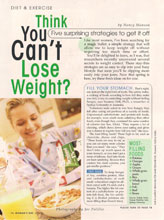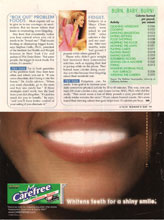Think You Can’t Lose Weight?
Five surprising strategies to get it off
Like most women, I’ve been searching for a magic bullet: a simple strategy that will allow me to keep weight off without taking too much time or effort.
You’ll be delighted to learn, as I was, that researchers recently uncovered several secrets to weight control. These stay-thin strategies are so easy to slip into your busy lifestyle that soon you’ll be slipping more easily into your jeans. Now that spring, is here, try these fresh ideas on for size.
Fill Your Stomach
That’s right, eat. Just eat the right kinds of foods. The satiety index, a ranking of foods according to how full they make you feel, is key to controlling weight without feeling hungry, says Susanna Holt, Ph.D., a researcher at Sydney University in Australia.
Volunteers were asked to rate how hungry they felt after eating set portions of a variety of foods. Unprocessed carbohydrate- and protein-rich foods, for example, were much more satisfying than other foods, even though they contained the same number of calories. “They require a lot of chewing, which slows down your eating, and gives you a chance to register how full you feel,” she says.
The least-filling foods? Those high in fat, such as chocolate, cheese and chips. “These foods are easy to eat, so you can eat many more calories than you need,” she says. “They don’t take up much space in your stomach, so you don’t get a sense of fullness. And fatty foods are least satisfying. Because they contain the most calories, you get smaller portions.”
Try this: To keep hunger at bay, combine protein, fiber and carbohydrates at each meal—a breakfast might be all-bran cereal with one percent milk and a banana. The higher the fat content of a carbohydrate- or protein-rich food, the less satisfying it is (boiled potatoes are more filling than French fries).
| Most-filling foods |
|---|
| Potatoes |
| Oranges |
| Apples |
| Grapes |
| Whole-grain pasta |
| Rice |
| Whole-grain bread |
| Fish |
| Beef |
| Beans |
Source: Satiety Index, Human Nutrition Unit, Sydney University
Sleep Well
Researchers have found that a lack of sleep often leads to overeating.” The act of eating is a way of gaining energy because it raises your metabolic rate,” says Connie Diekman, M.Ed., R.D., a spokesperson for the American Dietetic Association. “After a night of insomnia, your body may actually prompt you to fork in the food simply to keep you alert.”
Daytime fatigue may also spur you to turn to caffeine or sugar snacks, but these are quick fixes that ultimately only fuel fatigue. “The effects of sugars only last about an hour. Your energy level then crashes, and you have to eat more food to stay awake,” Diekman explains.
Caffeine’s effects last longer, but it can cause insomnia if you drink caffeinated beverages after noon or consume more than two cups a day.
Try this: To improve sleep, have a carbohydrate-rich snack, such as a glass of milk, low-fat popcorn, fruit, graham crackers or an English muffin and honey, one to two hours before bedtime. “Carbohydrates raise the level of the brain chemical serotonin, which will help you to sleep better,” she explains.
Eat More Fiber
A recent study performed at the USDA’s Human Nutrition Center in Beltsville, Maryland, shows that if you replace starches—potatoes, corn and squash—with fiber, your body will absorb fewer calories from the foods you eat.
Fiber binds some fat and protein to it, and they—along with some calories—exit the body rather than being digested. Starches are readily digested.
Try this: Eat about 24 grams of fiber a day by substituting fiber-rich foods for starches. The key is not to increase the amount you eat. “You’ll absorb about ninety fewer calories a day, which could help you lose nine pounds a year,” says David Baer, Ph.D.
| Great fiber sources |
|---|
| Limit white breads, pastas and rice, which are stripped of nutrients. To get the most fiber, include at least 11 servings of the following products in your daily diet |
| Whole-grain breads, cereals, pastas, crackers and other baked goods |
| Bran or oat products |
| Brown or wild rice |
| Beans and lentils |
| Fruits (particularly those with skins) |
| Vegetables |
Fidget
Subjects in a Mayo Clinic study were asked to eat 1,000 extra calories a day and not exercise. After two months, some had gained only two pounds while others gained 16.
Those who didn’t gain weight had increased their nonexercise activities, such as tapping their feet or pacing while on the phone. They burned more calories doing everyday activities because their fidgeting raised their metabolic rate.
Try this: Fidgeters can be made. Your goal is to increase your daily nonexercise physical activity by 30 to 60 minutes. This way, you can burn 200 more calories a day, says James Levine, M.D., Ph.D., who did the study. “That could mean a loss of thirty pounds a year, provided your calorie intake remains the same.” Every calorie burned counts. He’s even found that chewing calorie-free gum helps burn 11 calories per hour.
Burn, baby, burn!
| Activity | Calories burned per pound per minute |
|---|---|
| Cleaning windows | 0.026 |
| Cooking | 0.022 |
| Dancing (ballroom) | 0.023 |
| Eating (sitting) | 0.010 |
| Food shopping | 0.028 |
| Mopping the floor | 0.028 |
| Mowing the lawn | 0.051 |
| Playing cards | 0.011 |
| Playing piano | 0.018 |
| Raking leaves | 0.025 |
| Scrubbing floors | 0.049 |
| Sewing on a machine | 0.020 |
| Typing | 0.012 |
| Weeding the garden | 0.033 |
Source: University of California, Berkeley, The Wellness Encyclopedia
“Box Out” Problem Foods
Most experts tell us to give in to our cravings—in moderation. But we know where that leads: to overeating, even bingeing.
Any food that consistently makes you lose control when you eat it needs to be “boxed out.” That means limiting or eliminating trigger foods, says Stephen Gullo, Ph.D., president of the Institute for Health and Weight Sciences in New York City and author of Thin Tastes Better. “For some people, the trigger is snack foods. For others, it’s sweets.”
Try this: Try to limit quantities of the problem food. Also limit how often and where you eat it. “If you crave chocolate, don’t bring it into the house,” Dr. Gullo advises. “When you want chocolate, go to the store and buy one candy bar.” If these strategies don’t work, ban the food from your diet altogether. “It’s just too much for you to handle,” he says, “and you’ll have better control of your eating if you eliminate it.”

